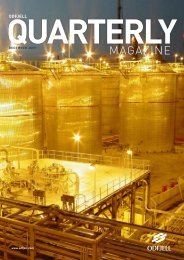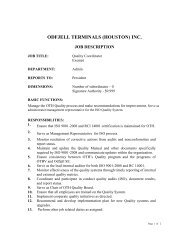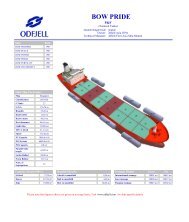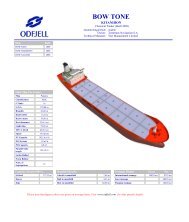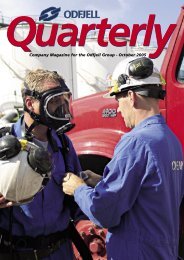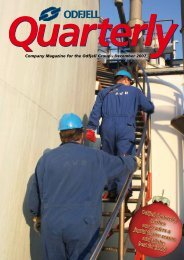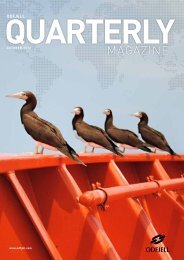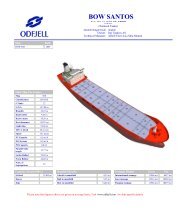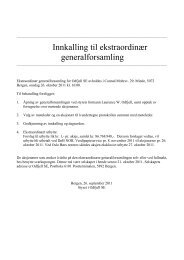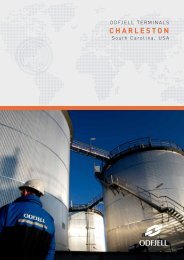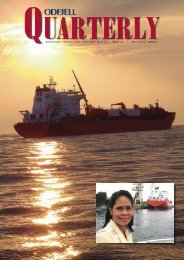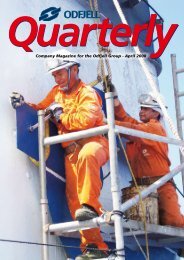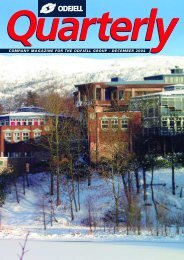You also want an ePaper? Increase the reach of your titles
YUMPU automatically turns print PDFs into web optimized ePapers that Google loves.
By Toralf SørenesEnclosed SpacesEnclosed spaces have two main risk factors;lack of oxygen, and presence offlammable gases that again can lead topersonal injuries or fatalities and fire orexplosions. Since our last Safety Bulletinboth scenarios have unfortunately materializedon ships used by <strong>Odfjell</strong>.Safety BulletinIn the November 2006 Safety Bulletinwe wrote about the dangers of N 2 inenclosed spaces. For our operations thisis mainly cargo tanks. Our 2006 articlewas triggered by a senior officer thatlost his life because he entered a tankthat was N 2 inerted. The ship was neitherowned nor managed by <strong>Odfjell</strong>,but she was commercially operated by<strong>Odfjell</strong> Seachem (OS). In August thisyear we had a very similar accident: asenior officer entered a tank that wasN 2 inerted and lost his life. Again, theship was commercially operated by OS,but neither owned nor managed by<strong>Odfjell</strong>. Other common denominatorswere, however, also noted. Both the deceasedwere experienced senior officersand, amongst other duties, in charge ofissuing tank entry permissions. Neitherof them used personal gas meters andboth were obviously JUST going intothe tank to fix/fetch or check something.By-standing crew did not intervene,possibly because a senior officerwas involved. We have said it manytimes before and will continue to repeatthe message, never by-pass or short-cutprocedures and checklists in this area. Atypical example is that something is lostor gets entangled on the first ladderplatform and one just enters becauseit is so close, both in distance and timeneeded.N 2 is very dangerous because of oxygendepletion in combination with anShip Security & PerformanceAt Risk Management we are presentlyin the process of updating our Ship SecurityPlan (SSP). This is a yearly processthat follows the annual review of theSSP made by the ships. We hope to completethis updating by mid October andwill take this opportunity to thank theships for valuable inputs. These structuredinputs from those out there in thefield will greatly assist us in making theanaesthetic effect. If exposed to it, onewill normally not fully understand whathappens and therefore not be able toact in a rational manner. In both casesthe officer who entered the tank encounteredproblems very quickly, lostconsciousness and fell to a platform. Theassisting crew raised alarm, evacuationwas initiated and the person broughtup on deck and first aid including administrationof oxygen was given. Thisoperation was done very quickly by welltrained crew, but unfortunately it wastoo late to save the persons life. Theabove examples are sad and show thattank entry procedures are not somethingto play around with. You may endup not getting a second chance andthere is no difference between ranksand seniority.The other accident involved hot work ina tank during a stay at a repair yard. Theship was owned and managed by <strong>Odfjell</strong>and had been at the yard for sometime when the accident occurred. Gasfree certificates had been issued bothfor the complete ship during pre-arrivalchecking and later on daily basis priorSSP slimmer, more user-friendly, and lastbut not least, a good and active instrumentfor making our ships and operationssafe and secure.In February 2006 we distributed ourfirst performance report at Ship Managementdepartment (SMD). These reportsare closely connected to our KPIs.They are distributed on quarterly basisto commencement of work. At normalday hours a small fire occurred ina tank. No damage of any significancewas noted, but a safety team from theyard attended to investigate. Shortlyafter their arrival on the site, a secondand stronger fire occurred and a personfrom the attending team was seriouslyburned and later passed away. The lessonlearned is that a chemical tanker iscomplex both with regard to constructionand cargoes, and a gas free certificateis only a piece of paper. Thereis always a possibility that flammablecargoes could be trapped somewherein blind ends on lines, low points, drainchocksor that oxygen/gas can leakfrom equipment used by the yard. In anenclosed space this may result in flammablegases/mixtures accumulatinginto a level that is dangerous. It is thereforevery important to maintain safetyawareness throughout the dry-dockingand to measure gas levels on a regularbasis. Smaller fires or “puffing” say thatsomething is wrong and all work mustbe stopped until the causes have beenfound and eliminated.and have continuously been expandedand improved. A few issues will, however,still need further refinement. Thereport is an important instrument ingetting a picture of where SMD standon important issues. This will help us toidentify areas that need particular focusand later to see if this focus has had thedesired effect.<strong>Odfjell</strong> <strong>Quarterly</strong> <strong>September</strong> <strong>2007</strong> 25



